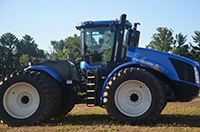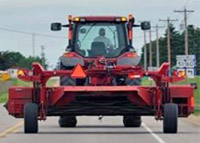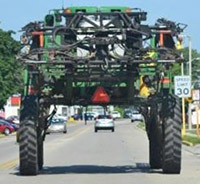Definition
The definition of implements of husbandry (IoH) is:
1. A self-propelled or towed vehicle that is manufactured, designed or reconstructed to be used and that is exclusively used in the conduct of agricultural operations. An “implement of husbandry" may include any of the following:
a. A farm tractor (referred to as Category A).
b. A self-propelled combine; a self-propelled forage harvester; self-propelled fertilizer or pesticide application equipment but not including manure application equipment; towed or attached tillage, planting, harvesting, and cultivation equipment and its towing farm tractor or other power unit or farm tractor or other power unit to which it is attached; or another self-propelled vehicle that directly engages in harvesting farm products, directly applies fertilizer, spray, or seeds but not manure, or distributes feed to livestock (referred to as Category B).

Example of IoH Category A

Example of Category B
Photo courtesy of UW Extension

Example of Category B -
Photo courtesy of UW Extension

Example of Category B
Photo courtesy of UW Extension
c. A farm wagon, grain cart, farm trailer, manure trailer, or trailer adapted to be towed by, or to tow or pull, another implement of husbandry (referred to as Category C).

Example of IoH Category C
Photo courtesy of UW Extension

Example of IoH Category C
Photo courtesy of UW Extension
2. A combination of vehicles in which each vehicle in the vehicle combination is an implement of husbandry as described above or in which an IoH Category C is towed by a farm truck, farm truck tractor, motor truck or agricultural commercial motor vehicle.
"Implement of husbandry" does not include any of the following:
- An agricultural commercial motor vehicle.
- A vehicle that is a commercial motor vehicle under federal law (49 CFR 390.5).
s.340.01(24)(a) and (b), Wis. Stat.
IoH Dimensions
- No width limitations. However, "wide" IoH have specific lighting and marking requirements. See the
Ag vehicle safety page.
- IoH over 8 feet, 6 inches wide being transported on interstate highways must have an oversize permit from the DOT.
- No height limitations.
- Operator of IoH remains responsible for ensuring safe clearance of any overhead obstructions.
- Single vehicle
- 60 feet
- No-fee permit may be required over 60 feet
- Two vehicle combination
- 100 feet
- No-fee permit may be required over 100 feet
- Three vehicle combination
- No more than 100 feet with speed restriction of 25 mph or less OR 70 feet at a speed greater than 25 mph.
- No-fee permit may be required if exceeding 100 feet in length.
- Towed units being drawn by a motor truck, truck tractor, or Ag CMV must be empty. “Empty” means less than 20 percent full.
- Length limits also apply to IoH being operated or transported for delivery, service, repair by dealer or farmer within 75-mile radius of business or farm. Beyond these dimensions, standard commercial (single or annual) permits are required.
- There is no length limit for an irrigation system being towed by a farm tractor, farm truck, farm truck tractor or motor truck temporarily operated upon a highway. (s. 348.07 (2)(e)3., Wis. Stats.)
- Maximum IoH/Ag CMV weight limits apply: Maximum single axle weight of 23,000 pounds and a gross vehicle weight of 92,000 pounds dependent on number of axles and axle spacing. These weight limits pertain for all IoH on state and US highways.
- These higher IoH weight limits are not allowed on Interstate highways. (s. 348.15 (9)(c)2.(d), Wis. Stat.) However, IoH traveling on the I-41 corridor
(s. 348.01 (2)(bd), Wis Stat.) are exempted from this provision.
- A no-fee permit may be required if gross vehicle weight or axle weight is greater than the IoH weight table.
- All operators must abide by seasonal or other special postings.
- Exemptions
- Empty potato harvester is exempt from axle weight limit. Also exempt from Class B road postings.
- Category B is:
- Exempt from axle weight limits on local roads unless local government authority passes ordinance or resolution limiting self-propelled IoH axle weight.
- Exempt from gross vehicle weight and axle weight limits when operating between fields and operated on the highway for a distance of 1/2 mile or less.
- Exempt from Class B road postings.
- IoH traveling for delivery, service, repair by dealer or farmer within 75-mile radius of business or farm is exempt from gross vehicle weight and axle weight limits. They are also exempt from Class B road postings.
Trailering IoH
Operators are allowed to transport IoH on trailers or semi-trailers to or from a farm-related destinations under the same weight and dimension limits that are allowable if the IoH were being operated, except on interstate highways.
If the 2-vehicle combination transporting an IoH exceeds the IoH length, axle weight or gross weight limit, the operator may apply for a no-fee permit.
Trailered IoH over 8.5 feet wide traveling on interstate highways must apply for an oversize permit from WisDOT.
IoH with Tracks
IoH with rubber tracks are allowed to operate on the road as long as the tracks do not damage the highway.
IoH with Tracks information sheet
Also of note
- There are no limits on hours of operation. However, all IoH must meet
lighting and marking requirements to ensure safety.
- Specific lighting and marking requirements apply to IoH that are 15 feet or wider or that extend over the center of the roadway.